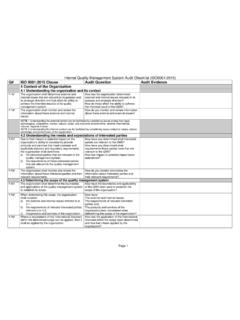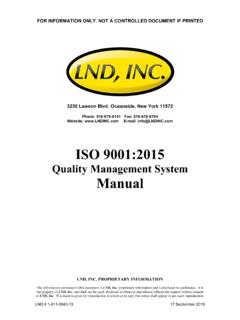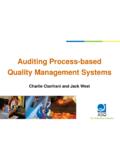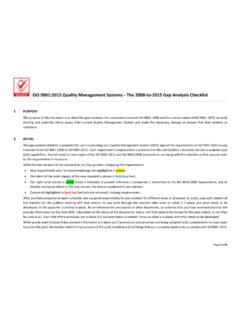Transcription of Checklist of Mandatory Documentation Required by ISO …
1 Checklist of Mandatory Documentation Required by ISO 9001:2015. W : E : : Qualitas International Certification Ltd. UK. Checklist of Mandatory Documentation Required by ISO 9001:2015. Our Vision: We aspire in association with our international alliances to become a premier key services & solutions provider to a wide range of industries in the region. Our mission is to promptly provide our customers with superior quality and cost effective services and products, while maximizing the welfare of our stakeholders. Our Mission: We aspire in association with our international alliances to become a premier key services & solutions provider to a wide range of industries and businesses. Our mission is to promptly provide our customers with superior quality and cost effective services , while maximizing the welfare of our stakeholders. General Objectives: To become a recognized supplier for the Quality testing , inspection and Standard Certifica- tion support businesses with the latest Know How in the field of Environment management system MIS Auditing.
2 To expand our scope of supplies in the FDA/GMP & CE. Marking continuously pursue profitable growth opportunities to our clients business throw QMS Auditing and certification .To provide the means to assist our custom- ers in achieving their develop joint ventures with regional and international Train- ing , Auditing and Certification industry provide a rewarding and pleasant work- ing environment for our international accreted auditors and team . BASIC OVERVIEW. It is easy to become overwhelmed with Documentation in the belief that every single process that is in place in an organization must be documented, without realizing that this is not nec- essary to meet the requirements of the ISO 9001 standard. The 2015 revision of the stand- ard become more liberal regarding Documentation requirements, meaning that there are no longer six Mandatory procedures as in the previous 2008 version of the standard. ISO 9001. also identifies many records that need to be maintained, which are generated by the process- es of the Quality management system .
3 Below is discussed which documents and records are Mandatory , and which are optional. 1- Which documents and records are Required ? 3. 2- Commonly used non- Mandatory documents 4. While ISO 9001 does not require that y ou document all of the procedures, there are several processes that are Mandatory to be established in order to generate the Required records that are outlined in the first section. Remember these processes and procedures are not Required to be documented; however, many companies choose to do so. One rule of thumb when deciding if you want to documen- ta process is this: if there is a chance that the process won'tbe carriedout as planned, then you should document it. I n many cases this is the best way to ensure that your Quality Man- agement system is reliably implemented. 3- How to structure documentsand records? Determining Context of the Organization and Interested Parties This is a new requirement of the standard that can bring some ambiguities, and it is a good idea to document the process of determining the context and identifying interested parties and their expectation s, since it is being done for the first time.
4 This document should contain all internal and ex ternal issues to be considered, as well as the process and responsibilities for identification of interested parties and their needs and expectations. Procedure for Deter- mining Contextof the Organization and Interested Parties can be of great help in implemen- tation of these new requirements. Contact us For more information, about: How to identify the context of the organization in ISO 9001. :2015 . 5. QMS Scope This documentis usually rather short, and written at the beginning of the ISO 9001 imple- mentation. Its purpose is to define the boundaries of the QMS and to determine to which parts of the organization the QMS applies. Normally, it is a standalone document called Scope of the QMS, although it can be merged into a Quality Manual. Quality Policy The Quality Policy is intended to be a company's documented intention to comply with ap- propriate requirements, increase customer satisfaction, and continually improve.
5 The policy is the focus for the company to work toward and should readily convey the goal of the or- ganization. It is a standalone document , but is often documented in a Quality Manual and sometimes posted throughout the organization as a way of communicating to all employees, since it is important that every employee understand how the policy relates to his or her job. Contact us For more information, about How to Write a Good Quality Policy. Risks and Opportunities that needto be addressed This is a new requirement that introduces significant changes to the QMS. According to the new version, the risks and opportunities regarding the QMS must be identified and addressed, but there is no requirement to use any methodology or write a procedure. The process of ad- dressing risks and opportunities includes consideration of internal and external issues rele- vant to the QMS, interested parties , and scope of the QMS. Considering the importance of this new requirement and the fact that it introduces a com- pletely new process into the organization, it is recommendedthat it be documented in the form of a procedure.
6 Contact us For more information, read: Risk-based thinking replacing preventive action in ISO 9001. :2015 The benefits and Methodology for ISO 9001 Risk Analysis. Quality Objectives and Plans for Achieving Them The requirements regarding setting the quality objectives remained as they were in the previ- ous version of the standard; they still need to be measurable and timed. However, the stand- ard now requires plans for achieving the objectives, meaning that the organization will have to assign responsibilities and dedicate resourcesfor achieving the objectives. These requirements can be met in sep- arate documents, but it is much easier to create a Quality Objectives document and fulfill all the above-mentioned requirements. Contact us For more information, about: How to Write Good Quality Objectives. 6. Competence, Training and Awareness records Introducing quality management into an organization often requires additional training of relevant employees.
7 Describing the process of managing human resources by documenting a procedure that defines identification of training needs, training planning, conducting and evaluation of training effectiveness , as well as assigning responsibilities for this, is the best way to ensure that the requirements are met. Although it is not a requirement of the stand- ard, good practice shows that the Procedure for Competence, Training and Awarenesscan be of great help to an organization. The standard explicitly requires only the evidence of competence, and that is the Training Record. About also: How to ensure competence and awareness in ISO 9001:2015. Procedure for Control of Documents and Records Managing documented information is defined by many requirements within clause 7 .5 in the standard. Activities of approval, update, managing changes, and ensuring that the relevantversion of the document is in use are best to be defined in a documented procedure.
8 The company must also define rules to maintain its records that show the QMS is imple- mented and maintained, including how they identify, store, and protect the records so that they can be retrieved as necessary, for the correct amount of time, and destroyed when no longer needed butnot before . If y ou need more information, about New approach to docu- ment and record control in ISO 9001 :2015. Sales procedure Although it is not a Mandatory procedure, the standard prescribes numerous rules regarding communication with customers, determining requirements related to product and services, and activities regarding review of these requirements. Good practice shows that the bestway to conform to all these requirements is to document them, together with responsibilities. The only Mandatory documented information here are the records of reviewing requirements related to product and service, as well as information aboutnew requirements for products and services.
9 Procedure for Design and Development Requirements regarding the design and development process are among the most demand- ing in the standard. Every step of the design and development process needs to be docu- mented in the form of a record, from design and development inputs, controls, and outputs, to changes in design and development. Considering all the requirements regarding the design and development process, it is best 7. to document the Procedure for Design and Development and define all Mandatory records thatshould accompany the procedure. Contact us For more information, about: ISO 9001 Design Verification vs. Design Validation. Procedure for control of externally provided processes, products and services (outsourced processes). Creators of the standard decided to use this rather robustformulation of something that is basically the Procedure for Purchasing and Evaluation of Suppliers. Although the purchasing processdoesn't have to be documented, the standard requires companies to establish control over its externally provided processes, products, and services.
10 The standard does require the criteria for evaluation, selection, monitoring, & re- evaluation of the suppliers to be docu- mented, and the best way to do it is through the procedure. Contact us For more information, about: Purchasing in QMS The Process & the Information Needed to Make it Work. Procedure for production and service provision The standard requires production & service provision pr ocesses to be under control in terms of availability of necessary documented information about product or service characteristics, intended results, availability of needed resources, monitoring and measurement activities, etc. This rather complex process w ill hardly achieve the intended outcomeswithout clearly de- fined rules documented in the Procedure for Production and Service Provision. About also: Understanding Product& Service Provision in ISO 9001 . Warehousing procedure The importance and necessity of this procedure will vary depending on the type of business the company performs, but the requirement for product preservation is one of the most cru- cial ones in the way of the productor service toward the end user.






